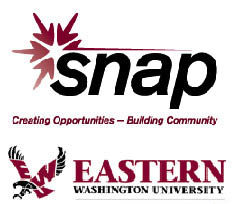
Home » Many qualify for help with heating bills
Many qualify for help with heating bills
Programs reached only one-fourth of eligible households in county

July 15, 2010
Some 43,000 households in Spokane County, or about 24 percent of all households in the county, were eligible during the winter of 2007-2008 for the two largest heating-assistance programs here, says a study done by the Eastern Washington University Institute for Public Policy and Economic Analysis.
Yet, from the winter of 2003-2004 through that of 2007-2008, the total number of households served fluctuated between 8,800 and 11,000, then rose to 13,140 in the winter of 2008-2009, the study says.
The study "verified what our concern was," that many people who are eligible for the assistance don't receive it, says Margaret Belote, energy program manager for Spokane Neighborhood Action Programs (SNAP), which manages both of the heating assistance programs under contracts. "It brought us to the realization that the concern was even bigger than we thought."
Belote says, "The funding dictates how many we can help." To get the assistance, people must make application, but before the study was done, SNAP didn't have an estimate of the number of households that qualified for assistance beyond those who got help, she says.
The study also says that about 21 percent of all U.S. households would qualify for heating assistance, and in Washington state about 18 percent of households qualify.
Anne Marie Axworthy, director of community development for Avista Utilities, which commissioned the study along with Aging and Long-Term Care of Eastern Washington, says the study "definitely accomplished what we hoped it would. It gave us a snapshot of how and how well the programs are meeting the needs of the households."
The Avista Foundation paid for the study, which showed that the households in need of assistance are concentrated in the city of Spokane, with the heaviest clusters in the central and eastern sections of the city.
The two heating-assistance programs are the Low Income Home Energy Assistance Program, which is funded by the U.S. government, and the Low Income Rate Assistance Program, which is funded by Avista Utilities through a small tariff and is available only to Avista customers.
Project Share, which is funded by Avista, its customers, other utilities, and their customers, is a separate, communitywide heating-assistance program that's tapped for emergencies such as when a household has less than 10 days supply of a deliverable fuel left and can't pay for more, Belote says.
Axworthy says the study's findings raise policy questions. "Whose responsibility is it to meet additional needs?" she says. "Is it the responsibility of utilities? What's government's responsibility?"
Those questions extend to the types of programs that should be offered and how they should be designed, including whether the best approach is to provide heating assistance grants or to reduce the heating bills of the poor by providing weatherization assistance, Axworthy says.
SNAP was able to help more households in 2008-2009 and again in 2009-2010 because the U.S. government provided more money than it had in earlier years. For 2008-2009, federal funds paid for just under $6 million in heating bills here, compared with $3.3 million in 2007-2008. The Avista-funded Low Income Rate Assistance Program paid for $1.6 million in such bills in 2008-2009 as 13,140 households received assistance.
This year, however, President Obama has put in his own budget proposal the smaller, 2007-2008 budget amount for heating assistance funds and has threatened to veto a bill that includes the higher amount, Belote says. She says he made the same threat last year, but signed legislation that provided the higher amount.
"What our funding level will be at for 2010-2011 will be determined sometime this fall, I guess," she says. "We have to have some pessimism."
This past winter, SNAP approved help for an estimated 14,000 households, but hasn't closed its books on the heating season yet and is unable to provide a final number. It was able to help more people in 2009-2010 because the weather was milder and some energy costs fell.
Patrick Jones, of the Institute for Public Policy and Economic Analysis, says that in Spokane County, roughly 30 percent of households that needed heating assistance received help in 2009-2010, compared with 16 percent nationwide.
"There's quite a bit better coverage in Spokane County," he says. "How much more can we do and should we do? An analysis like this can't answer that."
Jones says that Grant Forsyth, a professor of economics at EWU, was the lead investigator in the study.
Latest News
Related Articles



